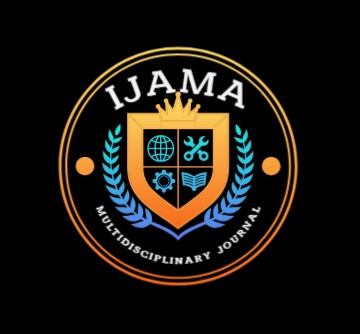International Journal of Advanced Multidisciplinary Application (IJAMA)

Author :Anjali Sharma¹, Rahul Iyer², Priya Singh³
Affiliation : 1,2,3Department of English Language and Literature, Loyola College, Chennai, Tamil Nadu, India
Journal :International Journal of Advanced Multidisciplinary Application.(IJAMA)
ISSN No:3048-9350
Volume/Issue : Volume 2 Issue 7 -2025/July ,Page No: 14 – 19
Abstract:
The rapid rise of digital communication platforms has profoundly influenced the English language’s evolution, altering its syntax, vocabulary, and usage norms. This study investigates how social media, texting, and instant messaging contribute to language change, focusing on the emergence of new lexical items, shifts in grammar, and pragmatic variations. Through qualitative content analysis and corpus linguistics, the research explores the dynamic interaction between digital communication modes and contemporary English, highlighting implications for language teaching, literacy, and cultural identity.
Keywords: Digital communication, Contemporary English, Language evolution, Online discourse, Linguistic change
Reference :
- Crystal, D. (2001). Language and the Internet. Cambridge University Press.
- Danet, B., & Herring, S. C. (Eds.). (2007). The Multilingual Internet: Language, Culture, and Communication Online. Oxford University Press.
- Tagliamonte, S., & Denis, D. (2008). Linguistic ruin? LOL! Instant messaging and teen language. American Speech, 83(1), 3-34.
- Thurlow, C., & Poff, M. (2013). Emoji, emoticons, and the paralinguistics of digital communication. In Herring, S. C., Stein, D., & Virtanen, T. (Eds.), Pragmatics of Computer-Mediated Communication (pp. 159-177). Mouton de Gruyter.
- Baron, N. S. (2008). Always On: Language in an Online and Mobile World. Oxford University Press.
- Androutsopoulos, J. (2014). Mediatization and sociolinguistic change: Key concepts, research traditions, open issues. European Journal of Communication, 29(2), 147-153.
- Crystal, D. (2014). The Cambridge Encyclopedia of the English Language (3rd ed.). Cambridge University Press.
- Seargeant, P., & Tagg, C. (2014). The Language of Social Media: Identity and Community on the Internet. Palgrave Macmillan.
- Herring, S. C. (2013). Discourse in Web 2.0: Familiar, reconfigured, and emergent. In Tannen, D., Hamilton, H. E., & Schiffrin, D. (Eds.), The Handbook of Discourse Analysis (2nd ed., pp. 127-149). Wiley-Blackwell.
- Crystal, D. (2016). Internet Linguistics: A Student Guide (2nd ed.). Routledge.
- Tagliamonte, S. (2016). So Cool, So Clever, So Trendy: The Use of Intensifiers in Youth Language. Cambridge University Press.
- Danet, B., & Herring, S. C. (2007). Introduction to computer-mediated communication. In B. Danet & S. C. Herring (Eds.), The Multilingual Internet (pp. 1-26). Oxford University Press.
- Thurlow, C., Lengel, L., & Tomic, A. (2004). Computer Mediated Communication: Social Interaction and the Internet. Sage.
- Tagliamonte, S., & Denis, D. (2010). Linguistic change in teen language: The case of verbal -s. Journal of Sociolinguistics, 14(3), 385-403.
- Locher, M. A., & Watts, R. J. (2008). Relational work and impoliteness: Negotiating norms of linguistic politeness in interaction. Journal of Politeness Research, 4(2), 159-178.
- Danet, B. (2001). Cyberpl@y: Communicating Online. Berg.
- Herring, S. C. (2004). Computer-mediated discourse analysis: An approach to researching online behavior. In Barab, S., Kling, R., & Gray, J. (Eds.), Designing for Virtual Communities in the Service of Learning (pp. 338-376). Cambridge University Press.
- Döring, N. (2002). Computer-mediated communication: Linguistic, social, and cross-cultural perspectives. Language@Internet, 1(2).
- Crystal, D. (2006). Language and the Internet. Cambridge University Press.
- Zappavigna, M. (2012). Discourse of Twitter and Social Media: How We Use Language to Create Affiliation on the Web. Continuum.
- Herring, S. C., & Paolillo, J. C. (2006). Gender and genre variation in weblogs. Journal of Sociolinguistics, 10(4), 439-459.
- Bou-Franch, P. (2015). Online language contact in Spanish/English interactions: A case study of three different CMC genres. Language@Internet, 12.
- Androutsopoulos, J. (2006). Introduction: Sociolinguistics and computer-mediated communication. Journal of Sociolinguistics, 10(4), 419-438.
- Tagliamonte, S. A., & Denis, D. (2010). Linguistic innovation in English instant messaging. Journal of Sociolinguistics, 14(3), 380-403.
- Herring, S. C., & Kapidzic, S. (2015). Teens, gender, and self-presentation in social media. International Handbook of the Demography of Race and Ethnicity, 45-60.
- Smith, S. W., & Duggan, M. (2013). Online dating & relationships. Pew Internet & American Life Project.
- Tagliamonte, S. (2012). Variationist Sociolinguistics: Change, Observation, Interpretation. Wiley-Blackwell.
- Crystal, D. (2012). English as a Global Language (2nd ed.). Cambridge University Press.
- Thurlow, C. (2006). From statistical panic to moral panic: The language of weblogs and the policing of youth identities. Discourse & Society, 17(6), 799-814.
- Danet, B. (2008). Textual harassment on the internet. In Danet, B. & Herring, S. C. (Eds.), The Multilingual Internet.
- Baron, N. S. (2008). Always On: Language in an Online and Mobile World. Oxford University Press.
- Herring, S. C. (2010). Web content analysis: Expanding the paradigm. The International Handbook of Internet Research, 233-249.
- Crystal, D. (2019). The Cambridge Encyclopedia of the English Language (4th ed.). Cambridge University Press.
- Tagliamonte, S. (2017). The Language of Social Media. Cambridge University Press.
- Androutsopoulos, J. (2013). Networked multilingualism: Some language practices on Facebook and their implications. International Journal of Bilingualism, 17(2), 185-205.
- Zappavigna, M. (2015). Searchable talk: The linguistic functions of hashtags. Social Semiotics, 25(3), 274-291.
- Herring, S. C., & Zelenkauskaite, A. (2009). Symbolism in a web 2.0 world: The case of internet memes. In Proceedings of the International AAAI Conference on Web and Social Media, 3(1).
- Tagliamonte, S. A., & Denis, D. (2010). Teenspeak: The language of youth in the age of digital communication. Annual Review of Applied Linguistics, 30, 93
Contacts
editorinchief.ijama@gmail.com
Working days : Mon- Saturday
Working Hours :9 am -5:30 Pm


